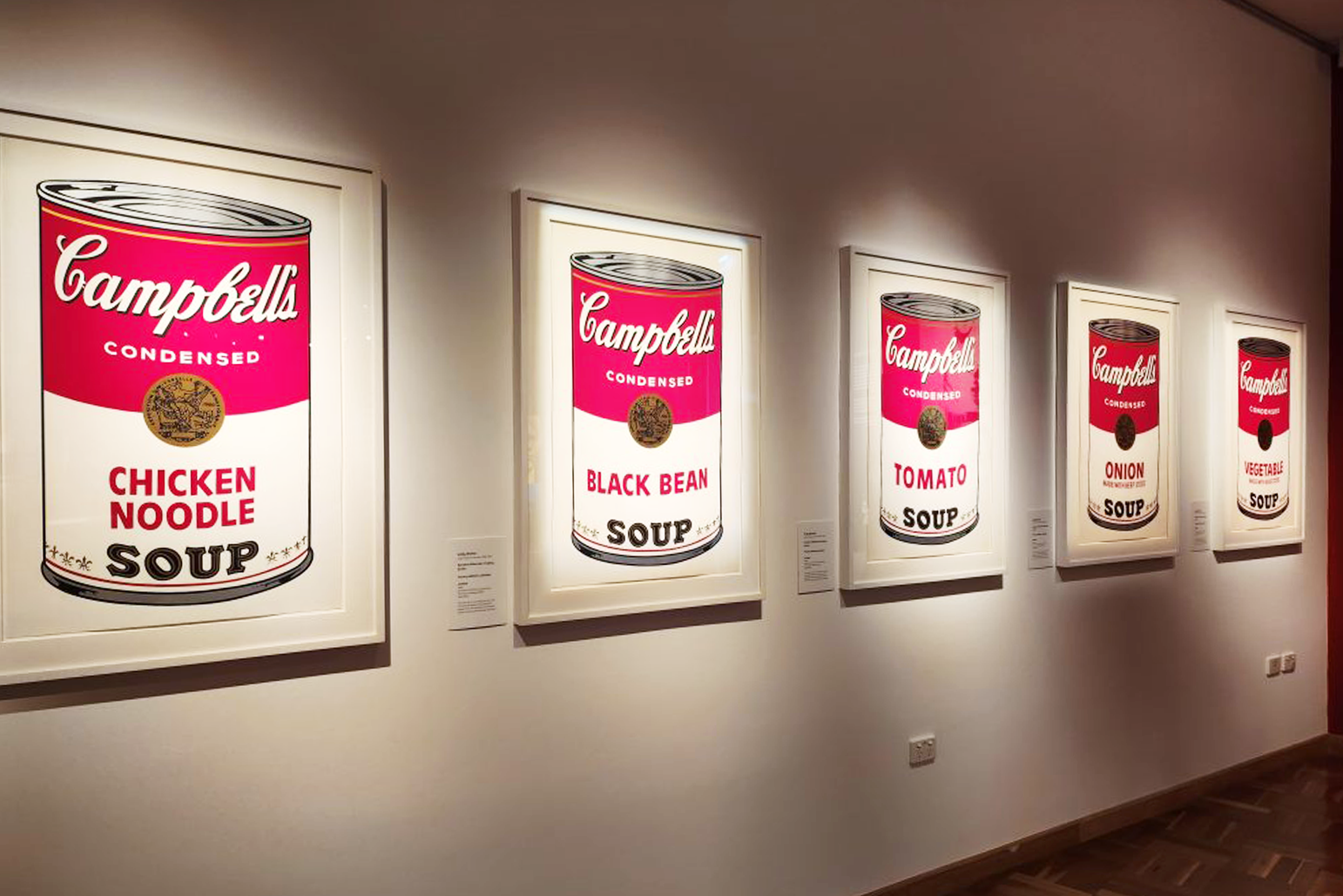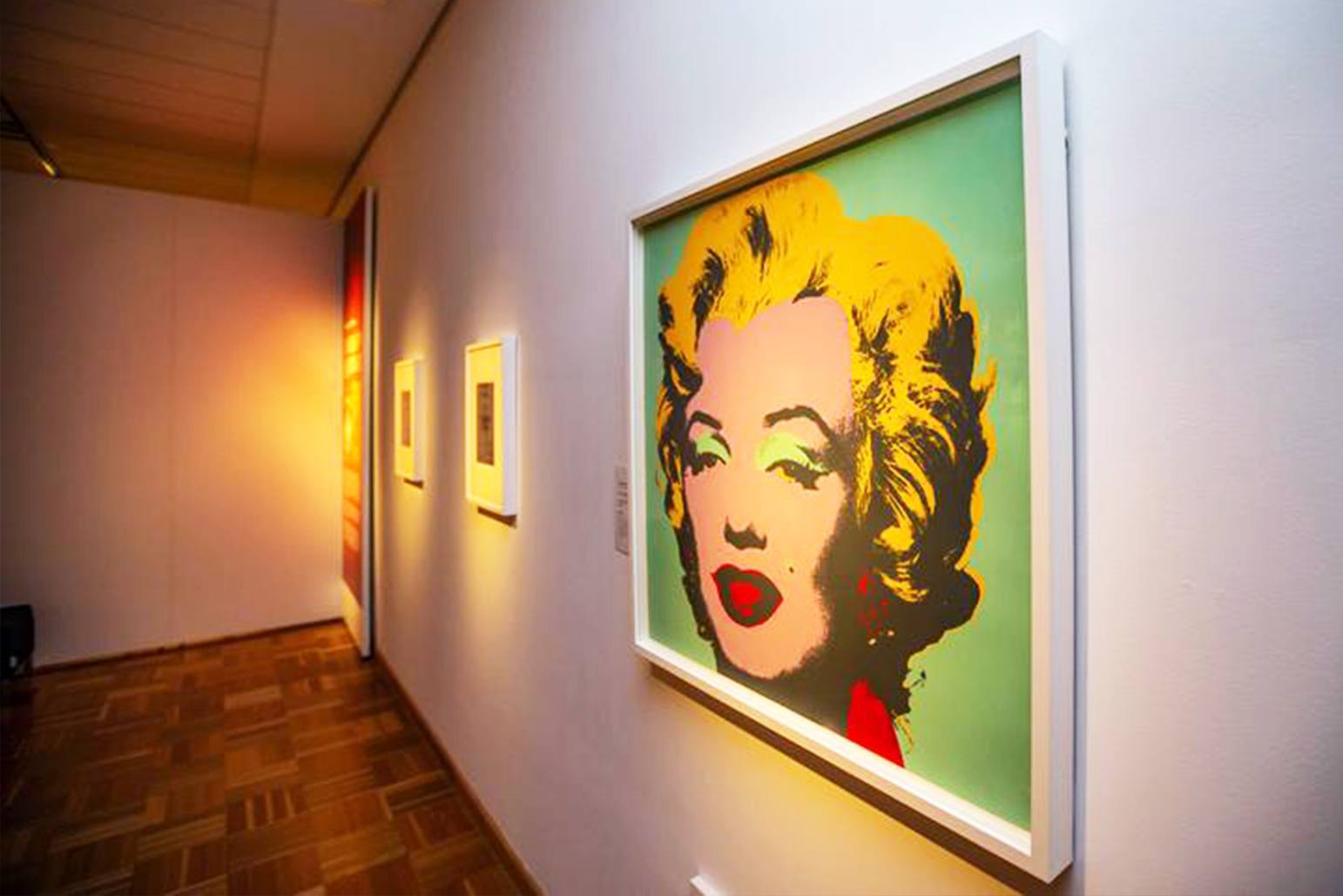


Recently, I caught a screening of the 1991 film Dingo. Set in the fictional Midwest town of Poona Flat (Meekatharra), the film begins with a young John “Dingo'' Anderson awestruck after a diverted plane lands in town and jazz trumpeter Billy Cross (played by none other than Miles Davis) steps onto the tarmac for an impromptu performance in front of the unsuspecting townsfolk. Dingo goes on to lead a life of music out bush—practicing the trumpet while making a buck hunting dingos and wild dogs. Eventually, Dingo makes his way to Paris in pursuit of his idol, Billy, and the promise of a serious musical career. In Dingo, Miles Davis plays a kind of martian; his band of aliens landing in Meekatharra only to depart like a UFO off into the infinite desert sky. Walking around the Wanneroo Regional Gallery to look at some of the National Gallery of Australia’s finest Warhols hits a similar note: the UFO has landed.
But this UFO is a familiar one. Warhol is a cliche, perhaps the most tiresome pop artist of the 20th century. Rarely does one see a Warhol that doesn’t feel like a hackneyed nostalgia trip—a bad one—and an exercise in art history's most banal excesses. Yet in Andy Warhol: ICONS at the Wanneroo Regional Gallery, these familiar works and repetitious lithographs are presented in a compelling light thanks to the unusual angle proposed by curator Robert Buratti.
Buratti cut his teeth curating exhibitions at his own gallery, most notably Windows to the Sacred, which toured nationally in the early 2010s. Windows to the Sacred included the works of Rosaleen Norton, James Gleeson, and, most notoriously, occultist Aleister Crowley (as well as a slew of other notable contemporary esoteric artists). Faced with Warhol, Buratti proposes an ingenious reading that revitalises these otherwise tired works. Andrew Warhola Jr. (who changed his name to Warhol after it was misspelled in a Glamour magazine article) was the sickly fourth child from a family of devoutly religious Ruthenian Catholics who regularly attended the St. John Chrysostom Byzantine Catholic Church. Making a living as a commercial artist in his youth, it wasn’t long before this striking young gay impresario, who had a knack for surrounding himself with similarly striking folks, presented his graphic works to the art market. Buratti mobilises this history in the opening didactic, titled “A New Pop Parthenon”, which proposes that:
It is a compelling argument. Here, the works are presented as being as related to the image-making of religious icons as they are outcomes of the increasingly entrenched celebrity culture of the 1960s and ‘70s: Elvis, larger than life and printed onto a silver-painted ground (reminiscent of the gold leaf in a religious icon), or the flattening of images to create simple, easily-recognisable portraits, like those of Marylin Monroe, Elizabeth Taylor, and others. Presented in this way, the strangeness and absurdity of celebrity culture bubbles to the surface.
A particular work that caught me off guard as an outlier to this proposal is the grainy, dark lithograph of Robert Rauschenberg from Warhol’s 1970 series Artists and Photographs. The image of a Rimbaud-looking Rauschenberg is murkily repeated across the composition in varying densities of light and dark. It is one of the more compelling images, appearing as though from another time—certainly out of step with the flashier Pop imagery that surrounds.
A recent review in The Conversation by academic, Christina Chau, noted that:
While this is true, it neglects to mention that ICONS presents an equally refreshing vision of Warhol. Certainly, it would have been easier to mount a traditional “Warhol for Dummies” experience. However, Buratti’s proposition is one that is simply presented and, in its simplicity, utterly compelling. ICONS is not the oddity of seeing world renowned work in an unsuspecting location, but also witnessing equally worldly curatorial logic which—in the best moments of the show—presents a fresh angle on all-too-familiar imagery.
Warhol in Wanneroo is the result of the audacious planning of Buratti and his colleagues at the Wanneroo Regional Gallery, who pounced on the $11.8 million Revive National Cultural Policy, which will see the National Gallery of Australia’s collection toured regionally over the next four years. And, while the intention of the policy is to revive the regions, ICONS is a testament to the regions reviving the collection in return.
Andy Warhol: ICONS is on display at Wanneroo Regional Gallery
Image credits: Andy Warhol: ICONS at the Wanneroo Regional Gallery.
But this UFO is a familiar one. Warhol is a cliche, perhaps the most tiresome pop artist of the 20th century. Rarely does one see a Warhol that doesn’t feel like a hackneyed nostalgia trip—a bad one—and an exercise in art history's most banal excesses. Yet in Andy Warhol: ICONS at the Wanneroo Regional Gallery, these familiar works and repetitious lithographs are presented in a compelling light thanks to the unusual angle proposed by curator Robert Buratti.
Buratti cut his teeth curating exhibitions at his own gallery, most notably Windows to the Sacred, which toured nationally in the early 2010s. Windows to the Sacred included the works of Rosaleen Norton, James Gleeson, and, most notoriously, occultist Aleister Crowley (as well as a slew of other notable contemporary esoteric artists). Faced with Warhol, Buratti proposes an ingenious reading that revitalises these otherwise tired works. Andrew Warhola Jr. (who changed his name to Warhol after it was misspelled in a Glamour magazine article) was the sickly fourth child from a family of devoutly religious Ruthenian Catholics who regularly attended the St. John Chrysostom Byzantine Catholic Church. Making a living as a commercial artist in his youth, it wasn’t long before this striking young gay impresario, who had a knack for surrounding himself with similarly striking folks, presented his graphic works to the art market. Buratti mobilises this history in the opening didactic, titled “A New Pop Parthenon”, which proposes that:
Warhol's obsession with celebrities was not mere idolatry but a reflection of a broader cultural phenomenon—the cult of celebrity. In the mid-20th century, figures like Marilyn Monroe, Elvis Presley, and Elizabeth Taylor attained a quasi-religious status, adored and scrutinised by the masses. Warhol's art magnified this phenomenon, effectively enshrining celebrities as modern-day saints.
It is a compelling argument. Here, the works are presented as being as related to the image-making of religious icons as they are outcomes of the increasingly entrenched celebrity culture of the 1960s and ‘70s: Elvis, larger than life and printed onto a silver-painted ground (reminiscent of the gold leaf in a religious icon), or the flattening of images to create simple, easily-recognisable portraits, like those of Marylin Monroe, Elizabeth Taylor, and others. Presented in this way, the strangeness and absurdity of celebrity culture bubbles to the surface.
A particular work that caught me off guard as an outlier to this proposal is the grainy, dark lithograph of Robert Rauschenberg from Warhol’s 1970 series Artists and Photographs. The image of a Rimbaud-looking Rauschenberg is murkily repeated across the composition in varying densities of light and dark. It is one of the more compelling images, appearing as though from another time—certainly out of step with the flashier Pop imagery that surrounds.
A recent review in The Conversation by academic, Christina Chau, noted that:
It is unexpected and oddly refreshing to see such famous works in a regional gallery. Perhaps this match between regional hub and high art is much more apt. […] Like many other American avant-garde artists, Warhol was interested in collapsing distinctions between art and the everyday.
While this is true, it neglects to mention that ICONS presents an equally refreshing vision of Warhol. Certainly, it would have been easier to mount a traditional “Warhol for Dummies” experience. However, Buratti’s proposition is one that is simply presented and, in its simplicity, utterly compelling. ICONS is not the oddity of seeing world renowned work in an unsuspecting location, but also witnessing equally worldly curatorial logic which—in the best moments of the show—presents a fresh angle on all-too-familiar imagery.
Warhol in Wanneroo is the result of the audacious planning of Buratti and his colleagues at the Wanneroo Regional Gallery, who pounced on the $11.8 million Revive National Cultural Policy, which will see the National Gallery of Australia’s collection toured regionally over the next four years. And, while the intention of the policy is to revive the regions, ICONS is a testament to the regions reviving the collection in return.
Andy Warhol: ICONS is on display at Wanneroo Regional Gallery
Image credits: Andy Warhol: ICONS at the Wanneroo Regional Gallery.
